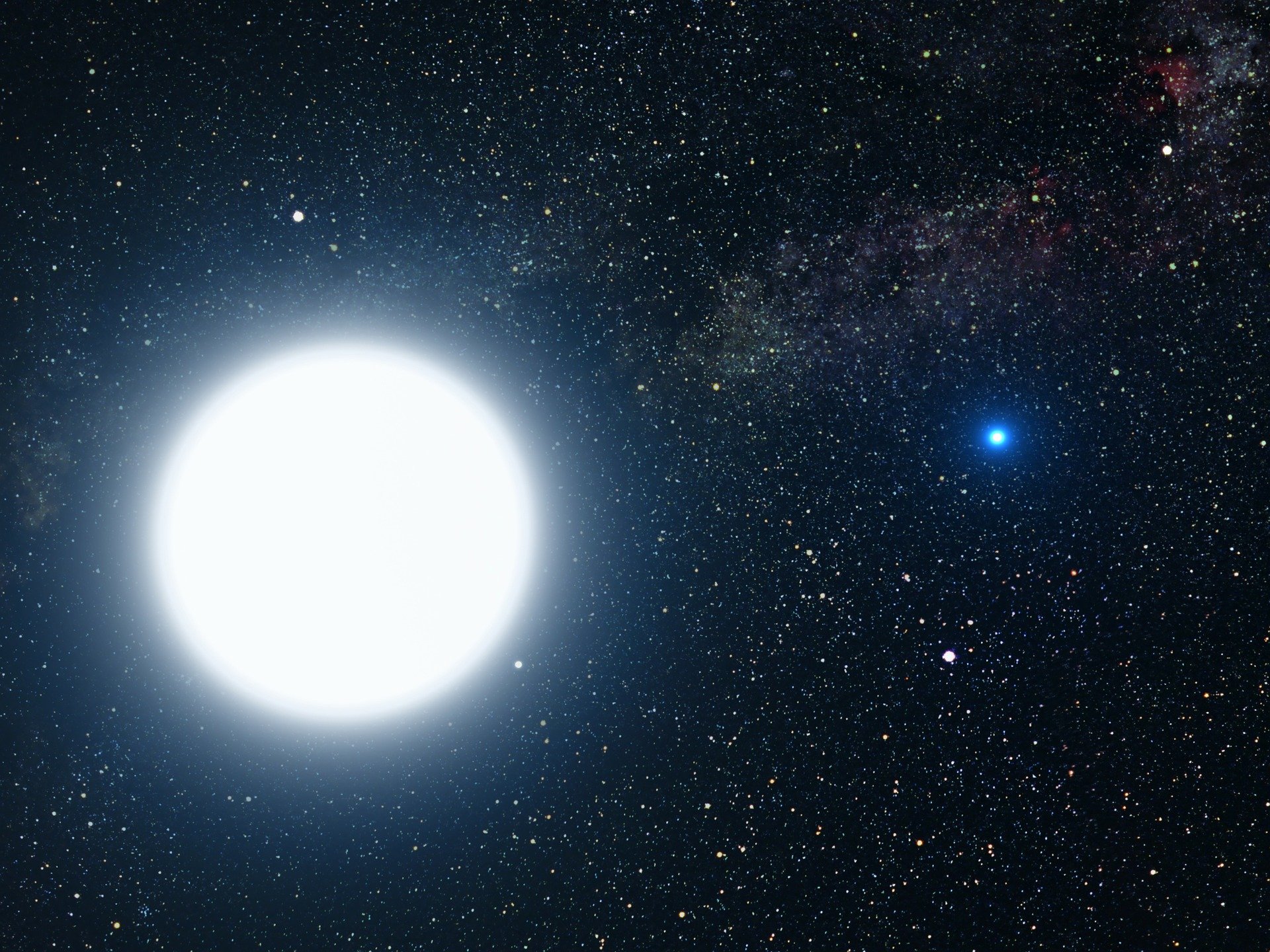SLOW AGEING STARS
Different ageing processes for the White Dwarfs
ANTIAGE STELLARE
Non tutte le nane bianche invecchiano allo stesso modo


Non tutte le stelle invecchiano allo stesso modo: alcune, nella fase finale della loro vita, conservano una piccola riserva di energia che permette loro di apparire più giovani. Lo ha scoperto un gruppo di ricerca guidato da studiosi dell’Università di Bologna e dell’Istituto Nazionale di Astrofisica (INAF) confrontando la popolazione di Nane Bianche in due sistemi stellari gemelli, grazie ad osservazioni ottenute con il telescopio spaziale Hubble.
Quello di “Nana Bianca” è lo stadio finale a cui va incontro la stragrande maggioranza delle stelle nell’Universo (circa il 98%), incluso il nostro Sole. In questa fase, resta solo il nucleo “nudo” della stella che, dopo aver perso gli strati esterni, non è più in grado di produrre alcuna forma di energia e si spegne lentamente, con un progressivo calo sia della luminosità che della temperatura.
Fino ad oggi si era sempre ritenuto che tutte le Nane Bianche invecchiassero allo stesso modo e con la stessa velocità. Il nuovo studio mostra invece per la prima volta che alcune Nane Bianche invecchiano più lentamente di altre perché in grado di trattenere un sottilissimo strato di idrogeno che consente loro di continuare a produrre energia attraverso reazioni termonucleari.
UNA NUOVA DEFINIZIONE DI “NANA BIANCA”
“Con le nostre osservazioni abbiamo scoperto che non tutte le Nane Bianche invecchiano allo stesso modo, e questa è davvero una scoperta sorprendente, che va contro quello che si era pensato fino a questo momento”, dice Jianxing Chen, studente di dottorato dell’Università di Bologna e associato INAF.
“La nostra scoperta cambia la definizione stessa di Nana Bianca così come siamo abituati ad insegnarla agli studenti nei corsi di astrofisica, e apre una nuova prospettiva sui processi che regolano l’invecchiamento delle strutture stellari”, aggiunge Francesco Ferraro, professore al Dipartimento di Fisica e Astronomia dell’Università di Bologna e associato INAF.
Non solo: questi risultati hanno anche dirette conseguenze sul modo con cui gli astrofisici misurano l’età delle stelle nella nostra galassia. Infatti, nell’ottica adottata finora, la relazione tra l’età e la luminosità o temperatura delle Nane Bianche era così stringente che il tasso di invecchiamento di queste stelle è stato utilizzato come una sorta di orologio naturale.
“I dati che abbiamo ottenuto mostrano che questo orologio va usato con cautela”, spiega Emanuele Dalessandro, ricercatore INAF. “Sappiamo ora che alcune Nane Bianche possono essere ad invecchiamento lento, per questo l’errore nella determinazione dell’età può essere rilevante: fino ad un miliardo di anni”.
AMMASSI STELLARI A CONFRONTO
A rendere possibile la scoperta sono state osservazioni profondissime ottenute con il telescopio spaziale Hubble. In particolare, gli studiosi hanno utilizzato immagini di due ammassi stellari (ammassi globulari) noti con i nomi di Messier 3 e Messier 13 (M3 e M13): due sistemi molto simili tra loro in termini di età e di contenuto di metalli, che per questo formano una coppia ideale per lo studio comparato delle popolazioni stellari.
E il confronto è stato una vera sorpresa. La popolazione di Nane Bianche in M13 è risultata decisamente più numerosa di quella di M3 nello stesso intervallo di luminosità (oltre 460 Nane Bianche sono state contate in M13, contro le 326 di M3). Una differenza particolarmente sorprendente anche tenendo conto che, globalmente, M13 contiene meno stelle di M3. La spiegazione – suggeriscono gli studiosi – è da cercare nelle proprietà stesse delle Nane Bianche di M13, e in particolare in un loro più lento processo di invecchiamento: affievolendosi più lentamente, il numero di stelle ancora osservabili in un dato intervallo di luminosità è maggiore in M13 che in M3.
UN SOTTILE STRATO DI IDROGENO
Ma perché queste Nane Bianche “più longeve” sono presenti in M13 e non in M3? La chiave del mistero è scritta nel loro passato. Quando le stelle si avvicinano alla fase finale della loro vita avviene infatti un processo di rimescolamento che trasporta l’idrogeno presente nel loro strato esterno fin dentro le regioni più interne, dove viene bruciato. Queste stelle arrivano così allo stato di Nana Bianca senza idrogeno residuo. In alcune stelle con una massa minore, però, questo processo non riesce ad attivarsi: è quanto avviene nella gran parte delle stelle di M13, mentre quelle di M3, essendo (seppur di poco) più massicce, vengono “rimescolate” e affrontano la fase finale della loro esistenza senza poter più produrre energia, invecchiando quindi più rapidamente. “La nostra scoperta dimostra che alcune Nane Bianche sono in grado di trattenere un sottilissimo strato di idrogeno, dell’ordine di un decimillesimo della massa del Sole, che è però sufficiente a permettere una minima attività termonucleare”, conferma Francesco Ferraro. “Riuscendo a produrre ancora un po’ di energia, queste stelle rallentano così il processo di spegnimento e di raffreddamento, e di conseguenza frenano il loro invecchiamento”.
Autore del post: Ufficio stampa Università di Bologna
Istituto di appartenenza: Al momento non lavoro per nessun itistuto (in cerca di lavoro/affiliazione).
Ruolo: Press Officer - Brains in Italy
Doi originale: https://doi.org/10.1038/s41550-021-01445-6
Link diretto alla fonte: https://www.nature.com/articles/s41550-021-01445-6
Articolo Divulgativo in Inglese:
Not all stars age in the same way. In their last phase of life, some stars keep a small reservoir of energy that allows them to look younger. It's the result of a study guided by the University of Bologna and the National Institute of Astrophysics (INAF) by comparing the White Dwarf population from two twin star systems through the space telescope Hubble. "White Dwarf" is the name of the final stage of most of the stars in the Universe (98%), including the Sun. In this phase, only the "naked" nucleus of the star is left. Lost all external layers, it can't produce any type of energy and will extinguish with a progressive fall in luminosity and temperature. Until today, it was believed that all the White Dwarfs aged at the same speed. For the first time, this new study shows that some White Dwarfs age slower than others because able to keep a thin hydrogen layer, allowing them to produce energy through thermonuclear reactions. A NEW DEFINITION OF "WHITE DWARF" "Through our observations, we discovered that not all White Dwarf age in the same way, and this is a surprising discovery which goes against what everyone thought until now", says Jianxing Chen, PhD student at the University of Bologna and INAF associate. "Our discovery changes the definition of White Dwarf itself as to how we used to teach it to the students in the Astrophysics lectures. Also, it opens a new perspective on the processes that regulate the star ageing", added Francesco Ferraro, professor at the Physics and Astronomy Department of the University of Bologna and INAF associate. Moreover, these results have a direct effect on the way astrophysicists measure stars age in our galaxy. The relationship between age and luminosity (or temperature) of the White Dwarf was so strict that the ageing rate of these stars was used as a kind of natural clock. "Our data show that this clock should be used with caution", explains Emanuele Dalessandro, INAF researcher. " We now know that some White Dwarfs can age slower; for this reason, the mistake in defining their age can be relevant: until one billion of years". STAR MASSES IN COMPARISON This discovery was possible thanks to the in-depth observations made through the space telescope Hubble. In detail, researchers used photos of two-star masses (globular clusters) known as Messier 3 (M3) and Messier 13 (M13): two systems very similar in terms of age and metal contents, forming a perfect couple for the comparison study of star populations. And the comparison was a real surprise. The M13 White Dwarf population resulted in more numerous than the M3 one in the same luminosity interval (over 460 White Dwarfs counted in M13, 326 in M3). A significant difference if we consider that M13 contains fewer total stars than M3. The explanation - the researchers suggest - has to be looked for in the M13 White Dwarfs properties, in detail, in their slower ageing process. Weakening slower, the number of still visible stars in a particular luminosity interval is higher in M13 than in M3. A THIN HYDROGEN LAYER Why these more "long-lived" White Dwarfs are present in M13 but not in M3? The key to this mystery is their past. When the stars are close to the last phase of their life, a remixing process transports the hydrogen from their external layer to the most internal regions, where it will burn. These stars arrive at the stage of White Dwarf without any residue of hydrogen. Otherwise, in some stars with lower mass, this process can't activate: it's what happens in most of the M13 stars, while the M3 stars, being more massive (even if slightly), will be "remixed" and will live their last stages of life without being able to produce energy, though ageing more rapidly. "Our discovery demonstrates that some White Dwarfs can keep a thin layer of hydrogen (of the order of one ten-thousandth the mass of the Sun), which is sufficient to allow a minimum thermonuclear activity", confirms Francesco Ferraro. "Being still able to produce energy, these stars slow down the extinguishing and cooling down process, though slowing their ageing".



